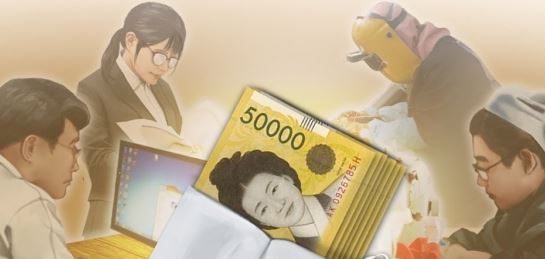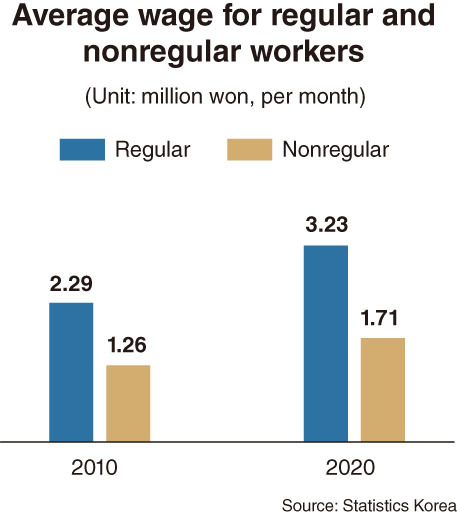
A graphic of employees in South Korea (Yonhap)
SEJONG -- The wage gap between regular and nonregular workers in South Korea has continued to grow over the past decade, state data showed.
According to Statistics Korea, the average monthly wage for regular workers came to 2.29 million won ($2,050) in 2010, which posted a gap of 1.03 million won, compared to 1.26 million won for nonregular workers.
In 2015, the gap between the two widened to 1.23 million won by 2.7 million won vs. 1.47 million won for nonregular employees. The state-run agency publicizes the figures once a year, in August.
In 2020, the wage disparity further expanded to 1.52 million won by 3.23 million won for regular employees vs. 1.71 million won for nonregular employees.
As of last year, 88 percent of regular workers were national pension policyholders while the percentage of pension subscribers among nonregular workers stayed at 37.8 percent.

(Graphic by Kim Sun-young/The Korea Herald)
Likewise, the percentage of health insurance and employment insurance subscriptions among regular workers reached 92.6 percent and 89.2 percent, respectively.
But the percentage of policyholders of the corresponding insurances among the nonregular workers stood at 49 percent and 46.1 percent.
Alongside the widening wage gap and relatively weak social benefits for nonregular jobs, the seriousness lies in the fact that the number and portion of nonregular employees is continually increasing.
The tally for nonregular employees increased from 5.71 million in 2010 to 7.42 million in 2020, with their portion of the total salaried workers climbing from 33.2 percent to 36.3 percent.
Further, 45.03 percent of all female workers in the nation were in nonregular job positions as of 2020.
The figure was the highest since the nation started compiling the relevant data in 2003, renewing the former all-time high of 45.01 percent in 2019.
The portion of nonregular jobs among female workers ranged between 39.9 percent and 41.1 percent during the previous Park Geun-hye administration.
As for men, the number of nonregular jobs reached 3.33 million of the total 11.36 million male workers, or 29.3 percent in proportion.
Collectively for men and women, the percentage of nonregular jobs inched down by 0.1 percentage point to 36.3 percent in 2020 on-year, but this is still quite high compared to the range (31.9-32.8 percent) during the Park administration.
The figure came to 36.4 percent in August 2019, the highest in about 12 years since it peaked at 36.6 percent in March 2007.
A labor research organization said that the government “has aggressively increased the number of nonregular workers among those in their 60s at state-funded agencies, who are working as cleaning employees.”
In addition, small-sized businesses actively hired those in their 20s in the form of nonregular position contracts in the wake of drastic hikes in statutory minimum wages in 2018 and 2019, he said.
The situation could suggest that the huge allocation of supplementary budgets for job creation during Moon’s term has only created unstable, low-paid jobs for both seniors and young people.
This might have contributed to the overall employment rate. But the Statistics Korea data showed that the portion of stable “regular workers” fell from 67.1 percent in 2017 to 63.7 percent in 2020.
By Kim Yon-se (
kys@heraldcorp.com)







